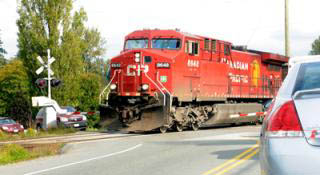
9 April 2009
Four-Year-Old Legal Opinion Says Trains Here to Stay

A Canadian Pacific Railway crosses Glover Road at the
Jardine crossing, just north of Highway 10. A legal opinion
made public Monday says trains have a legal; right to run
through Langley and cross municipal roads.
 Langley British Columbia - There is nothing in a
series of agreements dating back to 1907 to enable Langley Township to eliminate or limit CPR train traffic through Langley.
Langley British Columbia - There is nothing in a
series of agreements dating back to 1907 to enable Langley Township to eliminate or limit CPR train traffic through Langley.
That's a legal opinion the Township received four years ago, from Bull, Housser, and Tupper.
The seven-page legal document was released from in-camera by council Monday, when a delegate was appearing
to talk about a 102-year-old Township tramway access bylaw, said Township administrator Mark Bakken.
The seven-page legal opinion says in part:
"It is our view that the agreement provides CPR with authority to operate its freight railway along the BC Hydro
right-of-way and across municipal roads. There are no provisions in the agreement which enable the Township to limit
those rights. There is no provision in the agreement which provides for its termination, or for its renegotiation."
The legal opinion, by the law firm's Brian E. Taylor, is dated 2 May 2005. It refers to a 1907 Township bylaw granting a
right-of-way to Vancouver Power Company. The bylaw authorizes the "Company" to operate a "single or double
line railway or tramway for the transportation of passengers and freight" through the municipality "as part of the Electric
Railway System connecting the City of New Westminster and the Town of Chilliwack."
The legal opinion was "part of the process that began in the early part of the decade about what options we had (to resolve
road/rail conflicts here)," Bakken said Wednesday.
In 1950, B.C. Electric Railway Company applied to the Public Utilities Commission to cease rail passenger service subject to bus
service being instituted. As part of the order from the commission, the company agreed to pay $50,000 each to Surrey and Langley for
compensation for road upgrading necessary for bus service. The railway continued to operate freight service. This continued under BC
Hydro when B.C. Electric was taken over by the provincial government. Local freight service continues today by successor Southern
Railway of B.C., which purchased Hydro's freight railway in the 1980s.
In the 1960s, BC Hydro sought to extend its rail line to the Roberts Bank port, and in 1970 the provincial Minister of Transport,
pursuant to the Railway Act, ordered a number of upgrades, including that Glover Road be signalized "on an interim basis and
until such time as a grade separation has been effected."
Other requirements were a Crush Crescent illuminated red stop blinking signal, and standard stop signs at Topham Road, Smith Crescent,
and Worrell Road.
Some costs were the responsibility of the Township, some of the railway.
In 1993, BC Hydro granted CPR a Statutory Right-of-Way Agreement over the BC Hydro right-of-way (which
excludes Glover, Livingstone, Topham, Crush, Worrell Roads, and Smith Crescent.)
There is no mention in the right-of-way agreement of the level crossings at those roads, nor mention of who is
responsible for the maintenance of level crossings.
The legal opinion states that the agreement authorizes the operation of a freight railway on the right-of-way, by
"the Company and its successors and assigns, which would include the CPR."
The issue of access across Township roads is less clear, but the agreement assigns the company and successors authority to operate
"its system" across highways not being "less than 40 feet in width subject to a number of conditions."
Most of those conditions apply to the operation of a tramway.
The legal opinion indicates however that an argument that a tramway, but not a railway, has access over municipal roads has little
merit, for several reasons: the term "system" is broad enough to include a railway and tramway; it would make no sense
for the Township to have granted the company a right-of-way to operate a railway and a tramway, but then allow only the
tramway to cross municipal roads; and the company and its successors and assigns have been running freight on the BC Hydro
right-of-way and across Township roads for many years without objection by the Township.
With regard to costs of constructing grade separations, Taylor writes that the parties can resolve a disagreement through the Canadian
Transportation Agency (CTA) to determine responsibility.
The agency's published guidelines indicate a range of cost-sharing, depending on the reasons grade separations are
required, and who benefits.
A brief review of some agency decisions indicates that the predominant criteria for allocating costs is an assessment of the relative
benefits of the overpass.
Bakken said that an application did not go to the CTA.
"It never got to that stage," because discussions began in 2005, through the Langley Rail Task Force and the federal
government's Roberts Bank Rail Corridor Road/Rail Interface Study, completed in February, 2007, he said.
The federal study listed and established $307 million in funding for a number of overpasses along the rail corridor from Roberts Bank
to Mission, with the highest priority given the $51 million 64 Avenue/Mufford Crescent overpass of Glover Road.
The Township share of that project is $9.5 million.
Bakken said that another overpass here, designated in the Interface Study at 232 Street, will require no Township funding.
The Roberts Bank corridor projects funding partners include: TransLink, the federal and provincial governments, Port Metro
Vancouver, railway companies, and municipalities impacted by the DeltaPort expansion.
|
|